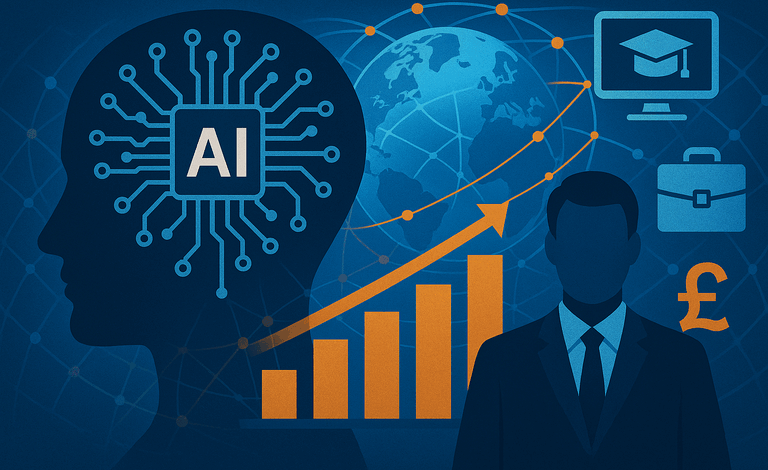
We often hear how artificial intelligence (AI) is transforming major industries, whether that’s by automating logistics in global supply chains, optimising financial models in multinational banks, or powering personalised customer experiences at tech giants. But what about the UK’s estimated 5.5 million small and medium-sized enterprises (SMEs)?
Too often, AI is painted as the preserve of big business, with equally big budgets. Yet this narrative is outdated and increasingly dangerous. As the UK Government ramps up efforts to position Britain as a global AI leader, including fresh commitments in the AI Opportunities Action Plan and significant investment in broadband infrastructure for underserved regions, SMEs have a critical window to adopt AI not just as a tool, but as a competitive advantage.
Levelling the playing field with AI
The most exciting, and perhaps under-reported, aspect of today’s AI landscape is its accessibility. With the rise of cloud-based platforms and no-code solutions, the traditional barriers to entry for AI, such as complex infrastructure, high upfront investment and the need for specialist talent, have dramatically reduced. You no longer need a team of data scientists to start exploring AI’s potential. Tools powered by generative AI, like automated content generation, intelligent chatbots, and customer sentiment analysis, are available off the shelf, ready to plug into daily operations. Cloud services offer scalable, subscription-based access to powerful technologies, allowing SMEs to experiment with and implement AI at their own pace and budget, without the need for heavy investment or in-house expertise. Meanwhile, IT support tools, including secure remote IT solutions, help ensure these systems remain operational and accessible, especially for businesses with distributed teams or hybrid work environments.
For SMEs navigating tight margins, economic volatility and talent shortages, AI is no longer a nice-to-have; it’s becoming essential. AI can process large volumes of data in seconds, turning it into actionable insight. This could mean forecasting sales trends with greater accuracy, identifying customer churn risks or automatically flagging anomalies in financial reports – saving time, money and costly mistakes.
Real-world applications: more than hype
While the media focus often falls on flashy, futuristic AI breakthroughs, SMEs are finding value in more grounded applications. For example:
- Customer service: AI-powered chatbots are reducing response times and improving satisfaction, even outside office hours. Some SMEs are already using AI to automatically categorise and prioritise support tickets or suggest tailored responses based on previous interactions.
- Marketing: Generative AI is enabling smaller teams to produce high-quality, personalised content at scale. Campaigns that previously took weeks to develop can now be created and tested in hours, enabling more agile marketing strategies.
- Operations: Analytics can give customer insights and reduce waste by learning from historical sales data, while autonomous systems can detect fraud or streamline repetitive back-office tasks, freeing up human capital for more strategic work.
These are not theoretical examples, they’re tools available to SMEs right now. The key is in choosing the right solution for your business challenge, not adopting AI for the sake of it.
Addressing the trust gap
Despite the promise of AI, many SME leaders remain understandably cautious. Concerns around data privacy, regulatory compliance, and workforce impact still dominate the conversation. That’s why transparency and ethics must sit at the core of any AI strategy.
As a tech CEO, I strongly advocate for SMEs to upskill internally. This doesn’t mean turning your team into coders overnight – but developing a baseline understanding of AI’s capabilities and limitations is vital. Encouraging staff to experiment, fail fast and learn how to work with AI (rather than fear it) is a cultural shift that pays dividends in resilience and innovation.
Equally, SMEs should work with vendors and partners who are clear about how AI tools are trained, how data is handled and how decisions are made. Trust is earned through clarity, not complexity.
AI as a growth enabler, not a job killer
There’s also an urgent need to reframe the conversation around AI and employment. Used responsibly, AI doesn’t replace people – it amplifies them. It handles the mundane, the repetitive and the error-prone tasks that eat into productivity. That frees up your people to focus on creative problem solving, customer relationships, and strategic thinking.
In other words, AI can turn a lean SME team into a high-output engine, without the overheads of traditional scaling.
A strategic imperative for the future
In 2025 and beyond, we’ll see a widening gap between SMEs that view AI as a strategic imperative and those that see it as a distraction or a threat. The former will attract more investment, better talent and greater customer loyalty. The latter risk stagnation or being outpaced entirely.
It’s also worth noting that government policy is increasingly favouring AI adoption. From funding schemes and digital upskilling initiatives to plans for AI regulation that support innovation while protecting consumers, the UK is laying the groundwork for SMEs to act with confidence.
However, strategy must lead technology, not the other way around. AI should be integrated within company structures and practices to support clear business goals to improve efficiency, expand into new markets, or build smarter customer journeys. Success doesn’t come from chasing hype, it comes from solving real problems with real tools.
Final thoughts
We are standing at a pivotal moment. The infrastructure, political will and technology are aligning to make AI a powerful growth lever for SMEs. But the opportunity won’t wait.
SMEs who start experimenting, upskilling and adopting AI now will be tomorrow’s industry leaders. Not because they outspent their competitors, but because they out-thought them.





